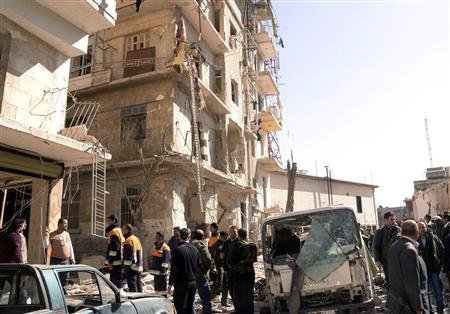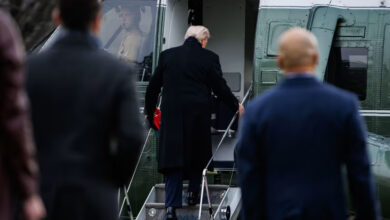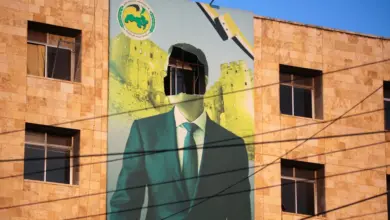
BEIRUT — An explosion struck near a Syrian government security building in the northern city of Aleppo Sunday while a harsh security crackdown prevented opposition rallies marking one year since the first nationwide protests of the uprising against President Bashar al-Assad.
The Syrian state news agency called the Aleppo explosion a “terrorist bombing” and said one policeman and one female civilian were killed, while 30 were injured. It was the second attack in two days on regime strongholds.
Three suicide bombings in the capital Damascus on Saturday killed 27 people. Two of them also targeted government security buildings and the regime the opposition, which it claims is made up of “terrorist” groups carrying out a foreign conspiracy.
Aleppo and the capital Damascus, Syria’s two largest cities, have been struck by a number of suicide bombings since December. Both are critical centers of support for Assad and have remained relatively insulated from the unrest shaking much of the country for the past year.
No one has claimed responsibility for any of the weekend attacks.
Mohamed Saeed, an Aleppo resident, said a car bomb exploded early afternoon about 200 meters from the Political Security Directorate. Security forces started shooting in the air and cordoned off the area to prevent people from approaching.
“It was a strong explosion. It shook parts of the city,” Saeed said, citing nearby residents. “White smoke was billowing from the area.”
The explosion did not seriously damage the security building, he said. But at that time of day the city’s central Suleimaniyeh neighborhood is usually crowded with people, especially on Sunday, the first day of Syria’s workweek.
The neighborhood has a large Christian population, Saeed said.
The string of large-scale bombings near government security buildings in Damascus and Aleppo that have added a mysterious element to the anti-government revolt. After other similar attacks, US officials suggested Al-Qaeda militants may be joining the fray.
A previously unknown Islamist group calling itself Al-Nusra Front to Protect the Levant claimed responsibility for previous attacks in a video posted online, saying it carried them out “to avenge the people of Homs.” Homs is an opposition stronghold in central Syria that has been hard-hit in the government crackdown.
Al-Qaeda’s involvement could further fuel the sectarian tensions that the uprising has already stoked. Al-Qaeda’s supporters are largely Sunni Muslim extremists. Syria’s military and political leadership is stacked heavily with members of the minority Alawite sect, an offshoot of Shia Islam to which Assad and the ruling elite belong. The Alawite leaders of Syria are closely allied with Shia Iran.
Sunnis are the majority in the country of 22 million and make up the backbone of the opposition.
The last major suicide bombing in Aleppo was on 10 February, when twin blasts struck security compounds, killing 28 people. Damascus has seen a half dozen suicide bombings since December, most hitting intelligence and security buildings.
Many activists consider 18 March 2011, the start of the anti-Assad uprising. Thousands took to the streets in cities across Syria on that day, and security forces killed marchers in the southern city of Daraa.
Since then, Assad’s security forces have violently sought to crush all signs of dissent, and protest and international condemnation have spread. Many in the opposition have taken up arms to defend themselves and attack government forces as the increasingly militarized conflict has become one of the bloodiest of the Arab Spring.
The UN says more than 8,000 people have been killed.
Jordanian Information Minister Rakan Majali said Sunday that attempts by arms dealers to smuggle weapons into Syria have gone up since the start of the year, but that Jordanian authorities foil them.
Also Sunday, activists posted videos online of an overpass on a main north-south highway they said had been destroyed by opposition fighters near the village of Khirbet Ghazaleh. The videos said the attack sought to block the army from bringing more tanks and military reinforcements into the area.
The Syrian state news agency said an “armed terrorist group” had blown up the bridge and estimated the damage at more than US$5 million.
Syrian activists said government forces prevented anniversary rallies.
The Britain-based Syrian Observatory for Human Rights said pro-government thugs known as “shabiha” quickly broke up a protest in Damascus by hundreds of people.
“They had just started protesting, but then some started chanting ‘The people want to topple the regime’ and the shabiha started beating them,” said Rami Abdul-Rahman, the group’s head.
Prominent opposition writer Mohamed Sayid Rasas was arrested, as were other protest leaders, he said.
Elsewhere, activists said army presence, as well as clashes between rebels and regime forces, deterred major demonstrations.
Troops and snipers restricted plans in the southern city of Daraa, considered the birthplace of the uprising, said nearby activist Adel al-Omari.
He said that at the uprising’s start, people from the surrounding region flooded in to participate in protests. Now many fear leaving their villages, so they hold smaller demonstrations there.
“They can’t have a big protests, only small quick ones that are spread out,” he said. “If they get too big or last too long, the army will come and crack down.”
Activists elsewhere said security forces opened fire on marchers in the provinces of Idlib in the north and Deir al-Zour in the east.
The Syrian government has barred most media from operating in the country, and activist claims could not be independently verified.




